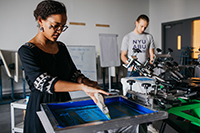Imagine a future where buildings and roads can self-repair cracks; cogs installed deep inside complex machines can independently heal structural wear and tear; smartphones can automatically mend their broken screens; all without human intervention.
It took nearly two years of analyzing, growing, breaking, poking, and prodding for Dr. Patrick Commins, postdoctoral associate researcher at NYU Abu Dhabi, to successfully create a tiny crystal that could do just that: repair itself.
He calls it his “Eureka!” moment.
And it’s a big deal because for the last 16 years smart materials — synthetically designed materials that can autonomously repair structural defects — have been limited to soft polymers, like rubber and plastic, which are not brittle and breakable like crystals. Most polymers even require certain temperatures or a chemical or biological catalyst to heal. But these crystals, developed in a lab at NYUAD, are very different.
Commins’ smart crystals can heal at room temperature without any external stimulus. In other words, they repair pretty much all on their own.
The research, published in leading peer-reviewed scientific journal Angwandte Chemie International Edition, was co-authored by Dr. Pance Naumov, associate professor of chemistry at NYU Abu Dhabi and Dr Hideyuki Hara, research scientist at Bruker in Yokohama, Japan.
This is actually a small breakthrough because it kind of shows a concept that was not considered possible before. It is the first time we’ve observed that rigid entities like crystals can self-repair.
“This is actually a small breakthrough because it kind of shows a concept that was not considered possible before,” said Naumov. “It is the first time we’ve observed that rigid entities like crystals can self-repair. This was not expected. It's certainly a shift in our understanding of crystals.”
How it works
So how exactly did a rigid crystal show properties normally displayed by softer materials? The answer is buried deep within the crystal itself, Commins explained. All matter is made up of atoms. Atoms are attracted to each other in different ways to form bonds and molecules. The molecules can remain disordered like in rubber or plastic materials, or they can assemble in ordered structures to form crystals. While the molecules deep inside a crystal are restrained from motion, the molecules on the surface can move around and be more fluid. Commins was inspired by this and decided to test the capabilities of crystals with sulphur atoms, which are able to form weak bonds.
“What happens when we break the crystal is that we have all these sulphurs moving around and when we press them together they reform their bonds and they heal,” he explained.
These kind of crystals don’t exist naturally. The pale yellow dipyrazolethiuram disulfide crystals Commins used in his research were grown in the lab and measure no bigger than a baby’s fingernail. Most of them were only about 0.5 mm thick.
“Crystals found in nature are made from minerals, like calcium and silicates but this crystal is different. It’s made specifically to have many close sulfur-sulfur bonds and they grow in rather small sizes. If it was bigger it would be better because then the broken surfaces would have more contact and more healing. Right now we have a very small surface area for it to touch,” he explained.
Even though the crystals require no external stimuli to repair, they still need to be helped along a little. A clean break is necessary because debris or indentations left in the crack can affect the healing process. So researchers made a shallow incision along the surface of the crystal then flipped it and placed it on mechanical pads, which gently pulled the crystal from either end until it separated at the incision. Next, the separated pieces were gently pressed together and left for 24 hours at room temperature. When researchers returned the next day, the two pieces had become one again. The only sign of trauma was the mark left behind by the cut; similar to scars on skin.
We believe other self-healing crystals exist and they are waiting to be discovered.
“It’s quite remarkable,” Commins said, and peers in the field seem to agree because the study is generating a lot of buzz in the chemistry world.
“We’ve definitely aroused interest among our colleagues, future researchers and graduate students.” said Naumov.
“We believe that it’s not isolated to this one material. We think other crystals can do it but no one has actually explored it. We’ve only explored one aspect of this potential self-healing crystal field. We believe other self-healing crystals exist and they are waiting to be discovered,” Commins concluded.


